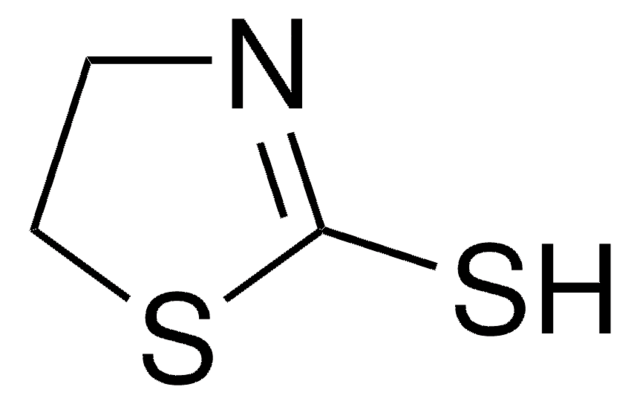733385
(11-Mercaptoundecyl)-N,N,N-trimethylammonium bromide
Synonyme(s) :
(11-Mercaptoundecyl)trimethylammonium bromide
Se connecterpour consulter vos tarifs contractuels et ceux de votre entreprise/organisme
About This Item
Formule empirique (notation de Hill) :
C14H32BrNS
Numéro CAS:
Poids moléculaire :
326.38
Numéro MDL:
Code UNSPSC :
12352300
ID de substance PubChem :
Nomenclature NACRES :
NA.23
Produits recommandés
Forme
solid
Niveau de qualité
Pf
113-118 °C
Température de stockage
−20°C
Chaîne SMILES
[Br-].C[N+](C)(C)CCCCCCCCCCCS
InChI
1S/C14H31NS.BrH/c1-15(2,3)13-11-9-7-5-4-6-8-10-12-14-16;/h4-14H2,1-3H3;1H
Clé InChI
SCOCXONJTURWMB-UHFFFAOYSA-N
Catégories apparentées
Description générale
(11-Mercaptoundecyl)-N,N,N-trimethylammonium bromide (MABr) is an organothiol which forms a self-assembled monolayer (SAM) that facilitates the immobilization of a variety of nanoparticles.
Application
MABr can be used to functionalize gold electrodes to fabricate sensing platform for bioelectronics-based applications. It can also be used in surface modification of gold-platinum based nanocrystals (Au-Pt NCs) that find potential applications in biomedicine and bioengineering.
This ammonium thiol molecule is reporated for the formation of photoconductive self-assembled monolayers.
Code de la classe de stockage
11 - Combustible Solids
Classe de danger pour l'eau (WGK)
WGK 3
Point d'éclair (°F)
Not applicable
Point d'éclair (°C)
Not applicable
Faites votre choix parmi les versions les plus récentes :
Déjà en possession de ce produit ?
Retrouvez la documentation relative aux produits que vous avez récemment achetés dans la Bibliothèque de documents.
Les clients ont également consulté
Preventing UV induced cell damage by scavenging reactive oxygen species with enzyme-mimic Au-Pt nanocomposites.
Xiong B, et al.
Talanta, 120(9), 262-267 (2014)
A halogen-free synthesis of gold nanoparticles using gold (III) oxide.
Sashuk V and Rogaczewski K
Journal of Nanoparticle Research, 18(9), 261-261 (2016)
Study of binary self-assembled monolayers of a novel anchoring thiol (11-mercaptoundecyl-N?, N ?, N?-trimethylammonium) in the electron transfer with glucose oxidase enzyme.
Baldo TA, et al.
Sensing and Bio-Sensing Research, 18(9), 37-44 (2018)
Notre équipe de scientifiques dispose d'une expérience dans tous les secteurs de la recherche, notamment en sciences de la vie, science des matériaux, synthèse chimique, chromatographie, analyse et dans de nombreux autres domaines..
Contacter notre Service technique











